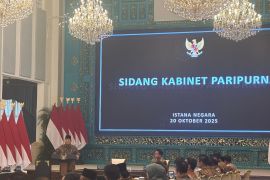"We are currently preparing the study," he remarked at the Scientific Oration of BJ Habibie Memorial Lecture: The Role of Science and Technology and Innovation towards a Golden Indonesia 2045, in Jakarta on Tuesday (July 23).
The minister affirmed that the current government and its successor would encourage the construction of this giant embankment.
The project is considered important in addressing the challenges of climate change and land subsidence that arise every year in the region.
"The national strategic project of the president-elect, Prabowo Subianto, considers that the northern part of Java Island experiences climate change every year in the form of land subsidence (the phenomenon of subsidence of the land surface)," Hartarto explained.
The minister remarked that the giant sea wall project is expected to provide optimal protection for the northern coastal areas of Java from the threat of flooding and abrasion.
He remarked that the project will also support economic sustainability and community welfare in the area.
Related news: Giant Sea Wall believed to prevent flooding
Earlier, the government planned to build a coastal embankment and a giant sea wall as one of the long-term projects.
This megaproject was initiated to overcome the threat of tidal floods and land subsidence in the northern region of Java Island.
The construction of the giant sea wall in Jakarta will take place in three phases. The first phase will involve the construction of coastal and river embankments, as well as the construction of a pump and polder system in the North Coast area of Jakarta.
The second phase will entail the construction of a sea wall with an open concept (open dike) on the west side of the north coast of Jakarta, which must be completed before 2030.
Meanwhile, the third phase will involve constructing a sea wall on the east side of the north coast of Jakarta, which must be completed before 2040.
Based on several studies, Hartarto stated that the estimated direct economic loss due to annual flooding on Jakarta's coast reaches Rp2.1 trillion annually (US$125 million) and could continue to increase with each passing year to Rp10 trillion (US$598 million) annually in the next decade.
Meanwhile, the estimated budget requirement for the first phase of the project is Rp164.1 trillion (US$9.8 billion) using the Government and Business Entity Cooperation (KPBU) scheme.
According to Hartarto, Java Island, the largest national contributor to gross domestic product (GDP), is currently facing challenges in the form of erosion, abrasion, flooding, and land subsidence, especially on the north coast of Java.
Related news: Jokowi to accelerate giant sea wall construction
Translator: Muhammad Harianto, Resinta Sulistiyandari
Editor: Yuni Arisandy Sinaga
Copyright © ANTARA 2024









